How to Fix Visual C++ Runtime ‘Error R6034’
Some Windows users are reporting that they end up seeing the ‘runtime error R634‘ when doing various things like opening an application or attempting to modify system files. This issue is confirmed to occur on Windows 7, Windows 8.1 and Windows 10.
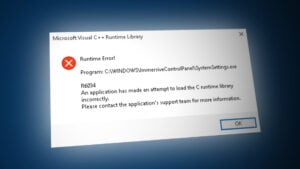
After investigating this particular issue thoroughly, it turns out that there are several different underlying causes that might be responsible for the apparition of this error code. Here’s a list of potential culprits:
- Missing / Corrupted Microsoft Visual C++ 2010 Redist Packages – As it turns out, a set of missing or corrupted Visual C++ Redist dependencies can very well be responsible for the apparition of this error code. In this case, you can fix the issue either by installing or reinstalling the missing / corrupted Microsoft Visual C++ 2010 Redist. package.
- Outdated 3rd party browser – If you’re seeing this error while trying to access the extension or add-in tab of your browser, chances are you’re seeing this error because you’re not using the latest build available. In this case, you can fix the issue by forcing the browser to update itself to the latest version.
- Missing admin access – According to a lot of affected users, this issue can also occur due to missing permission required by the application. If you find yourself fin this scenario, you should be able to fix the issue entirely by forcing the program to open with admin access.
- 3rd party backup software conflict – As it turns out, you can also respect to see this particular issue in the instances where you have previously installed a 3rd party backup software that might be conflicting with the built-in backup service. To resolve this conflict, you need to uninstall the 3rd party suite.
- The conflict caused by Apple support file – If you have iTunes installed on your computer, keep in mind that you can also expect to see this issue occurring due to an issue with Apple’s supporting files. As a lot of affected users have reported, you can expect to fix the issue by reinstalling the entire Apple ecosystem.
- System file corruption – Under certain circumstances, you can expect to see this issue occurring due to some type of system file corruption that ends up affecting the runtime protocols needed to run certain applications. In this case, you should start by running SFC and DISM scans in an attempt to fix superficial system file corruption. If that’s not enough, you’ll need to go for a repair install or clean install procedure.
Now that you are intimately aware of every scenario that might be causing this issue, here’s a list of verified fixers that other affected users have successfully used to resolve the ‘runtime error R634‘ error:
Method 1: Installing / Reinstall Microsoft Visual C++ 2010 Redist. Packages
As it turns out, more often than not, the ‘runtime error R634‘ error will occur due to a missing set of Visual C++ libraries that are needed to complete the operation that you’re currently trying to undergo.
This is even more likely if you’re encountering this issue while attempting to open up an application or initiate a scan with an installed utility.
If you see this error, it doesn’t necessarily mean that you’re missing the Visual C++ 2010 Redist. libraries – It’s also possible that you have the required package installed but it’s affected by system file corruption.
If this scenario is applicable, follow the instructions below to uninstall the current installation of Microsoft Visual C++ 2010 Redist. Packages before reinstalling a healthy equivalent:
- Press Windows key + R to open up a Run dialog box. Next, type ‘appwiz.cpl’ inside the text box, then press Enter to open up the Programs and Features menu.
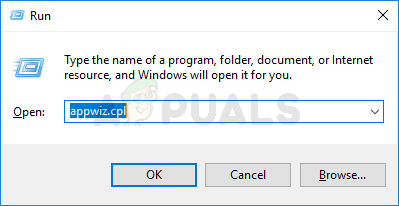
Opening up the Programs and Features menu Note: If you are prompted by the UAC (User Account Control) window, click Yes to grant admin access.
- Once you’re inside the Programs and Features menu, scroll down through the list of installed applications and locate the listings associated with Microsoft Visual C++ 2010 x64 Redistributable and Microsoft Visual C++ 2010 x32 Redistributable.
- Next, right-click on every listing and choose Uninstall from the context menu, then follow the on-screen prompts to complete the uninstallation of both the 32-bit and the 64-bit versions of the Visual C++ Redist.
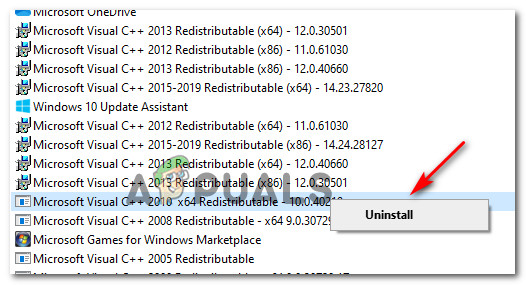
Uninstalling the problematic Visual C++ Redist. package - Once both Visual C++ Redist has been uninstalled, restart your computer, then wait for the next startup to complete.
- Open your default browser and download & install the following Visual C++ 2010 Redistributable packages:
Microsoft Visual C++ 2010 Redistributable Package (x86)
Microsoft Visual C++ 2010 Redistributable Package (x64) - After you’re inside the download page, select your language, then click on the Download button.
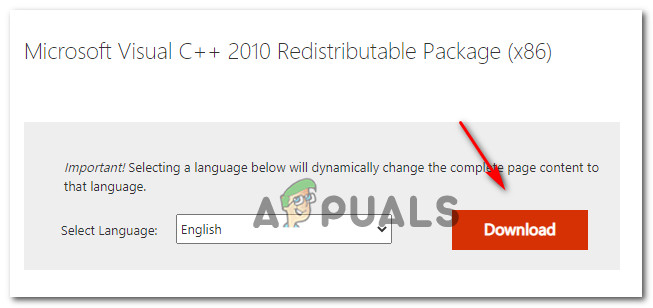
Downloading the missing visual c++ package - After the download is complete, double-click on the vcredist executable, click Yes at the UAC (User Account Control), then follow the instructions to complete the installation of the missing Visual C++ 2010 Redist. Package.
- Once the missing Visual C++ 2010 packages are installed again, repeat the action that was previously triggering the ‘runtime error R634‘ and see if the problem is now fixed.
In case the same problem is still occurring, move down to the next potential fix below.
Method 2: Updating your Browser to the latest version (if applicable)
In case you’re encountering this issue while attempting to perform a certain action inside your browser (such as opening the add-in or extension bar), this might be due to an outdated browser infrastructure.
Several affected users that were dealing with the same problem have confirmed that the issue was finally resolved after updating their browser version to the latest build available.
Of course, the instructions on how to do this will be different from browser to browsers – The majority of browsers are configured to auto-update themselves by default.
But since the issue is mainly reported to occur on Firefox and Chrome, we’ve put together 2 subsides that will walk you through the process of updating your browser to the latest version available.
Follow the guide that’s applicable to your 3rd party browser of choice:
A. Updating your Google Chrome browser
- Open Google Chrome, then click on the action button (top-right corner of the screen) from the browser window.
- Once you are inside the context menu of your Google Chrome browser, access the Help submenu, then click on About Google Chrome.
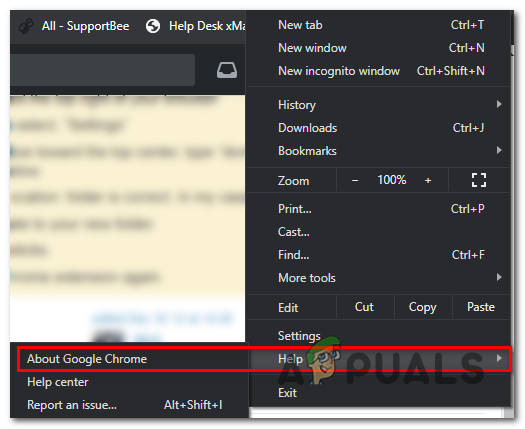
Accessing the About Google Chrome menu - After you’re inside the About Google tab, your browser should automatically begin to scan for a new version.
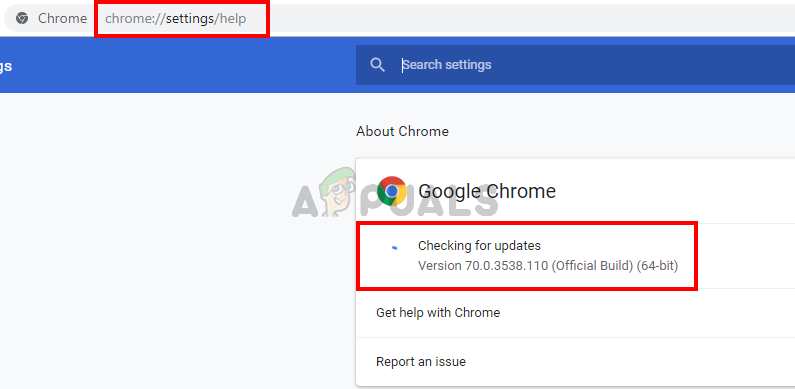
Updating Google Chrome to the latest version - If a new browser version is found, your browser will automatically download and install it.
- Once the operation is complete, restart your computer and repeat the action that was previously causing the ‘runtime error R634‘ to see if the issue was fixed.
B. Updating your Mozilla Firefox browser
- Open up Mozilla Firefox, then click on the action button in the top-right corner of the screen.
- Next, click on the Help tab from the main menu of your browser, then click on the About Firefox menu from the context menu that just appeared.
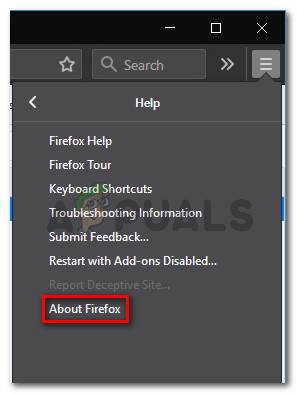
Accessing the About Firefox menu - After you’re finally inside the About Mozilla Firefox menu, click on the Restart and update the Firefox button (will only appear if a new version is available)
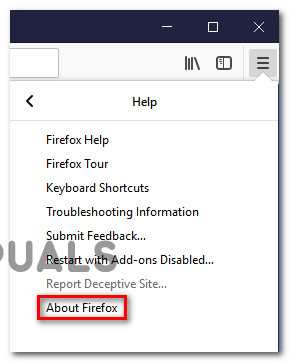
Updating Firefox browser to the latest version Note: If you are prompted by the UAC (User Account Control) prompt, click Yes to grant admin access.
- Once your browser is updated, restart your computer and see if the problem is fixed once the next startup is complete.
In case you are still encountering the same ‘runtime error R634’, move down to the next potential fix below.
Method 3: Forcing the program to run with Admin Access
If you’re encountering this issue while using a 3rd party program that is not part of the suite included on Windows by default, you can expect to see the runtime error R634 occurring because the program doesn’t have enough permissions to utilize Visual C++ Runtime dependencies.
Several affected users encountering the same issue have confirmed that they finally managed to fix the issue after forcing the affected program to open with admin access.
If you think this scenario is applicable, follow the instructions below to open the executable with admin access and make the change permanent if the change is a success.
Follow the instructions below to force the affected program to run with admin access and modify the default behavior so that the program always runs with administrative privileges:
- Right-click on the executable that is causing the issue, then choose Run as Administrator from the context menu that just appeared.
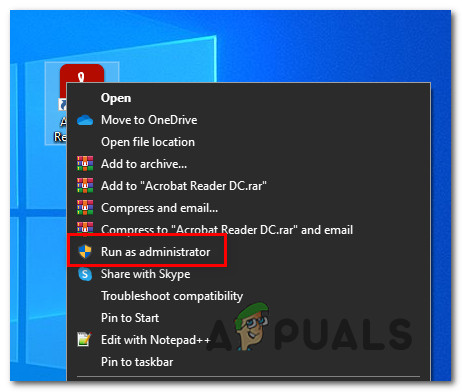
Running the executable as administrator - If you’re prompted by the UAC (User Account Control), click Yes to grant admin access.
- After you have successfully opened the program with administrative privileges, repeat the action that was previously causing the issue and see if the problem is now fixed.
Note: In case the ‘runtime error R634’ error is no longer occurring while admin rights are allowed, follow the remaining instructions below to always force admin rights on the executable. - Right-click on the executable that is causing this issue, then choose Properties from the context menu that just appeared.
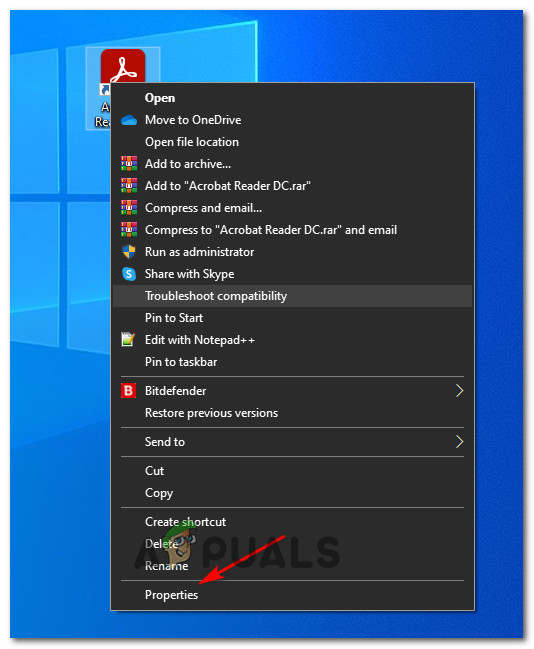
Accessing the Properties screen - Once you’re inside the Properties screen of the affected program, click on the Compatibility tab, then check the box associated with Run this program as administrator before clicking Apply to save the changes.
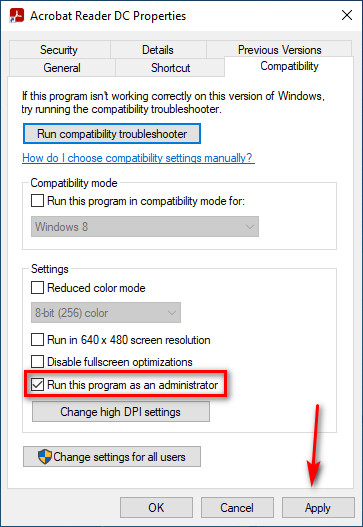
Running the program as administrator
If the issue is still not occurring, move down to the next potential fix below.
Method 4: Uninstalling the Conflicting Backup software (if applicable)
As it turns out, you can also expect to see this error if this runtime dependency is conflicting with a 3rd party backup software. As it turns out, the majority of 3rd party backup players (including EaseUS Backup and Acronis) might trigger the runtime error R634 when conflicting with the built-in backup process.
Several affected users that were dealing with the same issue have reported that the issue was finally fixed after they uninstalled the conflicting software.
If this scenario is applicable, follow the instructions below to effectively uninstall the conflicting 3rd party backup tool that is causing the runtime error R634:
- Press Windows key + R to open up a Run dialog box. Inside the text box, type ‘appwiz.cpl’ and press Enter to open up the Programs and Features menu. When you’re prompted by the UAC (User Account Control), click Yes to grant admin access.
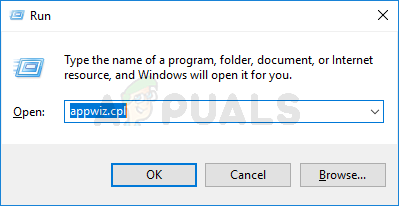
Opening the Programs and Features menu - Once you’re inside the Programs and Features menu, scroll down through the list of installed programs and locate the backup software that you suspect might be triggering the error.
- When you see it, right-click on it and choose Uninstall/Change from the context menu to initiate the uninstallation process.
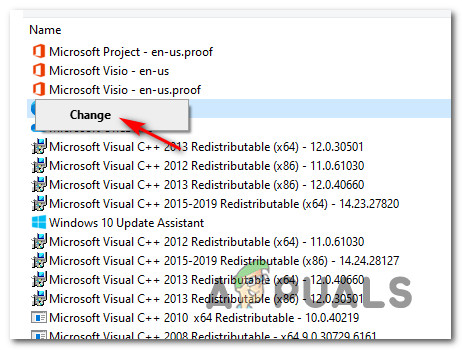
Uninstalling the backup prompt - Inside the uninstallation screen, follow the on-screen prompts to complete the uninstallation process, then reboot your computer.
- After your computer boots back up, see if the runtime error R634 is now fixed
Method 5: Reinstall every iTunes program (if applicable)
If you’re actively using iTunes on your Windows computer, you can also expect to see the runtime error R634 due to a conflict caused by an inconsistent Apple installation file.
Several affected users that were also dealing with this issue have reported that the issue was finally resolved after they uninstalled every component belonging to Apple before reinstalling everything from scratch.
However, keep in mind that the exact steps of uninstalling iTunes and every associated Apple component will be different depending on if you’re using the desktop version or the UWP (Universal Windows Platform).
Because of this, we’ve put together two different sub guides that will walk you through the instructions of reinstalling every iTunes component.
Follow sub guide A if you’re using iTunes UWP (Windows 10 Only) and sub guide B if you’re using the classic desktop version:
A. Reinstalling iTunes for UWP
- Start by pressing Windows key + R to open up a Run dialog box. Next, type ‘ms-settings:appsfeatures‘ and press Enter to open up the Apps & Features tab of the Settings app.
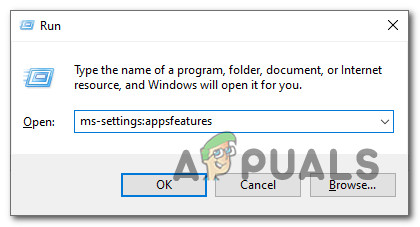
Accessing the Apps and Features screen - Inside the Apps & Features menu, use the search function in the top-right corner to search for iTunes. At the next menu, click on iTunes from the list of results, then click on Advanced Options hyperlink.
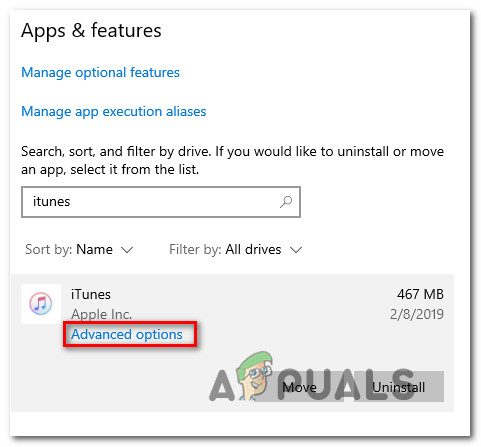
Accessing the advanced menu of itunes - Next, inside the Advanced Options menu, scroll all the way down to the Reset tab and click on the Reset button.
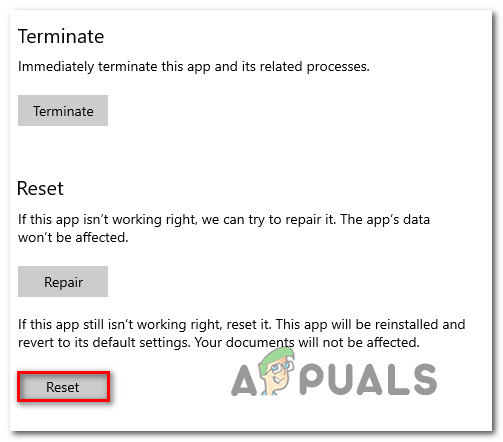
Resetting the iTunes app - At the confirmation prompt, click on the Reset button once again, then wait for the operation to complete.
Note: During this operation, your iTunes state will be reverted back to the default state and every component will be reinstalled. Don’t worry about this procedure affecting your existing library, because it won’t. You will still maintain ownership and you can re-download the content locally once the operation is complete. - Once you have successfully reinstalled the UWP version of iTunes, repeat the action that was previously causing the runtime error 46034 and see if the problem is now fixed.
B. Reinstalling iTunes for Desktop
- Start by pressing Windows key + R to open up a Run dialog box. Next, type ‘appwiz.cpl’ inside the text box and hit Enter to open up the Programs and Features menu of the Classic Control Panel.
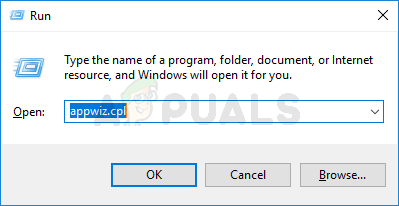
Opening the Programs and Features menu - Inside the Programs and Features screen, click on the Publisher column at the top to filter the list of installed programs via their publisher. This will make it a whole lot easier to uninstall the main iTunes application along with every supporting software.
- Once you have a clear view of every product published by Apple Inc., go ahead and start to uninstall them systematically by right-clicking each entry, clicking Uninstall. Next, follow the on-screen prompts to complete the uninstallation process.
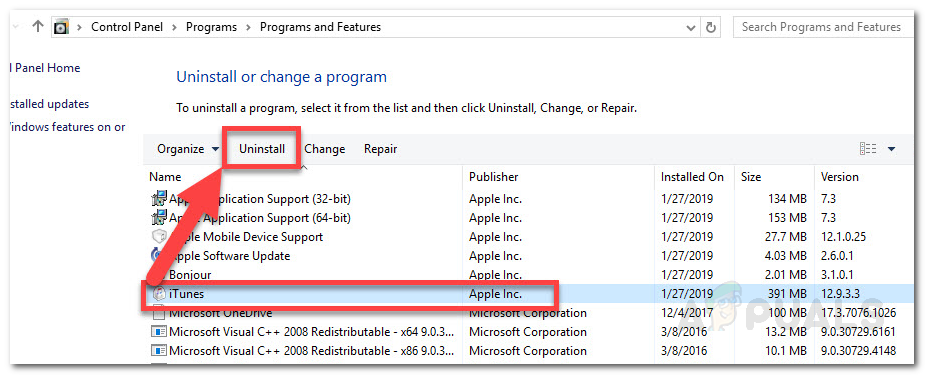
Uninstalling iTunes and every supporting app - After you uninstall iTunes along with every supporting software, restart your computer and wait for the next startup to complete.
- Once your Windows computer boots back up, go ahead and your browser in order to access this iTunes download page.
- Inside the download page, scroll down to the Looking for other versions section and click on Windows to download the latest version of iTunes.

Downloading the latest version of iTunes - After the installation is complete, open the installer and follow the instructions inside to install the latest version of iTunes on your computer. You will then be asked to install the supporting software.
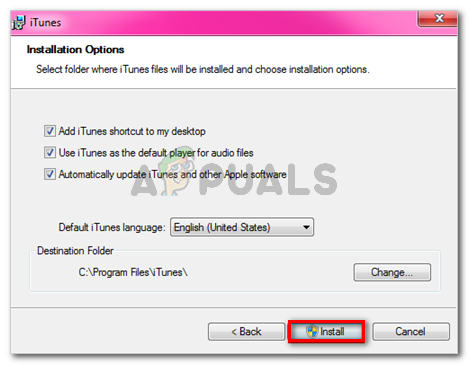
Installing iTunes for desktop on your computer - Once the installation is complete, reboot your computer once again and see if the problem is fixed at the next computer startup.
In case the same runtime error R634 issue is still occurring, move down to the next potential fix below.
Method 6: Deploying SFC and DISM scans
As it turns out, you can also expect the runtime error R634 to occur due to some type of system file corruption that is affecting the current Windows installation. This is quite common in cases where you’re also experiencing other runtime errors (with a different error code).
If this scenario looks like it could be applicable, you should run a couple of scans with two built-in utilities – System File Checker (SFC) and Deployment Image Servicing and Management(DISM).
Although hese two tools share some similarities, we recommend running both scans in quick succession in order to improve your chance of fixing the corrupted system files.
Start with a simple SFC scan.
Important: After you initiate this procedure, it’s very important to not close the CMD window even if the utility looks like it froze. Wait patiently until the process is complete, as interrupting the operation might cause logical errors on your HDD or SSD.
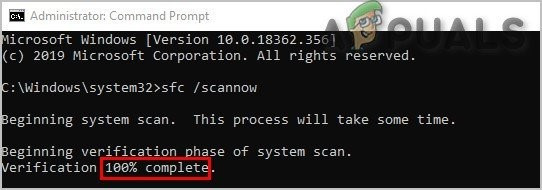
Note: This is an entirely local tool that will not require you to have a reliable internet connection.
After the SFC scan is finally complete, reboot your computer and see if the issue is fixed once the next computer startup is complete.
If the same runtime error R634 problem is still occurring, go for a DISM scan and wait until the operation is complete.
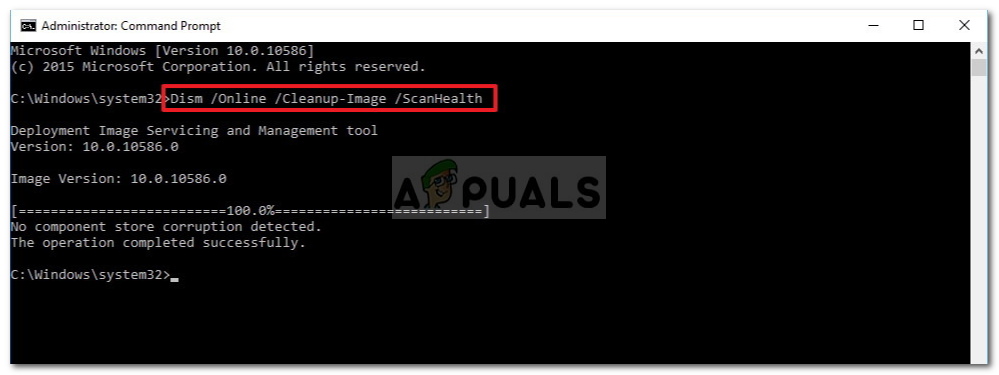
Note: This utility works differently from SFC – It uses a sub-component of Windows Update to download healthy components to replace corrupted instances of system files. Because of this fact, you need to make sure that you have reliable Internet before initiating this operation.
Once the DISM scan has been completed successfully, restart your computer and check if system audio playback is restored.
In case the same runtime error R634 issue is still occurring, move down to the next potential fix below.
Method 7: Refreshing every Windows component
If none of the fixes above have allowed you to fix the runtime error R634 issue, there’s a very good chance that your system is dealing with some type of system file corruption that will not be resolved conventionally.
If this scenario is applicable, the only viable fix left is to reset every Windows component completely with a procedure like clean install or repair install (in-place upgrade).
Option A: A clean install is an easier procedure since it will not require you to insert or plug in a compatible installation media.
Note: But unless you take some extra step to back up your data in advance, you will lose your files, user preferences, and every installed program and game.
Option B: A repair install (in place repair) is more tedious to deploy and you will need to use compatible installation media. However, the main advantage is that this operation will only touch Windows components – Which means that personal files, games, applications, documents, and everything else that’s not OS-related will not be affected by this procedure.




